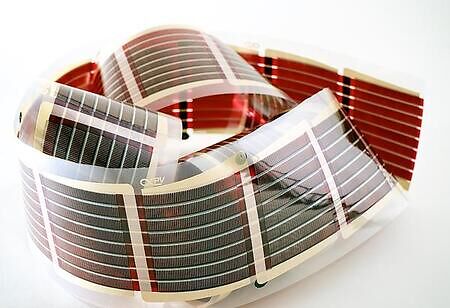
Organic Solar Cells: The New Era of PV Technology


Technologies to utilize nature’s resources for human needs are as old as the first human civilizations. The attention fluctuated away from renewable sources as the industrial revolution progressed on the basis of the concentrated energy locked up in fossil fuels. This was compounded by the increasing use of reticulated electricity based on fossil fuels and the importance of portable high-density energy sources for transport – the era of oil. It's an undisputed fact that solar energy is one of the most promising solutions to meet net-zero carbon emissions by 2050. Solar-generated power has been advertised as having the highest potential to meet our ever-growing energy demands in today's life. At present solar energy meets around two percent of the world's energy needs. The energy contained in the solar rays is more than enough to meet the energy needs today and in the future. But the need of the hour is solar cells that are cheap and environmentally friendly. Despite, it should be able to absorb the large quantity of solar rays and should convert it to electrical energy.
Organic solar cells based on organic semiconductors are increasingly emerging as a sustainable option. But just a few years ago, they could not stand in comparison with traditional silicon-based solar cells for efficiency.
Features and Applications of Solar Cell
The solar cells contain perovskite materials as the light-supplying active layer; these are most commonly a hybrid organic-inorganic lead or tin halide-based material. The term perovskite refers to any materials with the same crystal structure as the mineral CaTiO3. Any crystal with the generic form ABX3 is highly ordered and has a large bandgap, making it ideal for photovoltaics applications.
In addition, the stability of perovskite solar cells is limited. There are also concerns about the potential environmental impacts of lead-based absorbers, which can leak when the cell degrades.
An experiment measured the solar efficiency of the new eco-friendly solar cells to be 19.9 percent with peppermint oil and 21.2 percent when walnut aroma food additives. The new polymer was also shown to enhance the solar cell’s stability (conventional perovskite solar cells are moisture sensitive) and prevent lead leakage through the polymer’s ability to chelate lead while maintaining 88 percent efficiency after 30 days at 40-50 percent humidity.
For instance, copper indium gallium selenide (CIGSe) is a thin-film solar cell that offers several advantages over traditional silicon solar cells. Thin-film solar cells are about 100 times thinner, cheaper to make, and are easier to install on rooftops and vehicles. But when we compare it with other photovoltaic materials used in thin-film solar cells like amorphous silicon, cadmium telluride, and organic materials, CIGSe absorbs light more strongly and can be prepared into thinner films. However, they contain a buffer layer of cadmium sulfide, which is highly toxic and carcinogenic. This makes finding alternative, non-toxic materials essential for large-scale production and installation of CIGSe panels.
Mats Fahlman, a professor at the Laboratory of Organic Electronics at Linköping University, says, “To enable the full potential of organic solar cells to be exploited, there is a need for a clear picture of how they work. We have now obtained that picture. This provides a better understanding of how to create new efficient and sustainable solar cell materials.”
Organic solar cells are becoming more popular as they are made up of organic semiconductors. However, they were not up to the mark in terms of efficiency with standard silicon-based solar cells. Today, many countries are seeded in testing the practical limits of wind and solar (variable renewable energy, VRE). The relatively dilute nature of wind and solar mean that harnessing them is very materials-intensive – many times that from energy-dense sources. With the wind turbines developed, solar photovoltaic technology is much more efficient, and there are improved prospects of harnessing the energy in tides and waves. Solar thermal technologies, in particular (with some heat storage), have great potential in sunny climates. With government encouragement to utilize wind and solar technologies, their costs have decreased. They are now in the same league per kilowatt-hour dispatched from the plant as the costs of fossil fuel technologies, especially where there are carbon emissions charges on electricity generation from them.
A research team from Linköping University and colleagues from Hong Kong demonstrated that energy loss could be avoided by employing various donor-acceptor materials that aid the electron’s escape from its hole. After that, energy loss decreased, and efficiency improved. The issue was that no one knew how it had happened. It was evident that it worked, but it was unclear why.
How does the Organic Solar Cell Work?
In organic solar cells (OSCs), both charge generation and charge recombination occur at the donor (D) and acceptor (A) interfaces. Therefore, the energy level alignment (ELA) at D–interfaces is a key parameter for a fundamental understanding of OSCs. For example, in fullerene-acceptor-based OSCs (FA-OSCs), an energy offset of over 0.3 eV is usually observed in efficient devices. This offset, determined by the energy difference between the highest occupied (ΔHOMO) or the lowest unoccupied (ΔLUMO) molecular orbitals of the donor and acceptor, was commonly believed to provide the necessary driving force for efficient charge separators. Adjacent to this, there is a common belief in FA-OSCs. A wide range of non-fullerene-acceptor-based OSCs (NFA-OSCs) shows high efficiencies under negligible or even zero HOMO or LUMO offsets. The energy offsets are usually either estimated from the optical measurements by determining the energy difference between singlet excitons and charge-transfer states or estimated from cyclic voltammetry (CV) measurements, assuming that the vacuum level alignment at the D–A interfaces provide a rough estimation of the D–A interface ELA. The contrast between FA-OSCs and NFA-OSCs indicates that different regimes of device physics and photophysics are reached in NFA-OSCs.